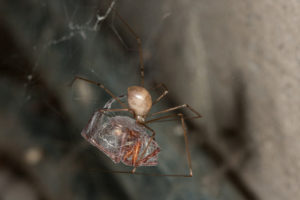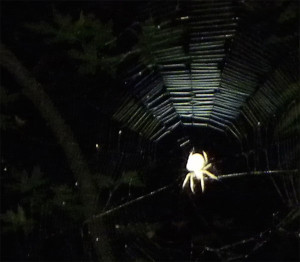How does a spider’s spinneret work? -Mary Hanson, Sacramento
Spinnerets are used for the production of silk, a complex fiber that is used to make webs, draglines, egg sacs, and more. To better understand this process, we have to go into the body of the spider. Within each spider’s abdomen are a variety of silk glands which can vary in number depending on the species. Some of the oldest lineages, including relatives of California’s tarantulas and trapdoor spiders, have only a single type of silk gland, while some orb weavers, like the one pictured here, can have up to eight different kinds. Each gland a produces a protein-rich liquid which connects to numerous minute spigots at the tip of the spider’s spinnerets. When silk is needed, tiny valves behind each spigot control its release, and as the fluid is compressed through the spigot’s openings, tension orients the molecules into a solid, thread-like structure.
Of course, the production of silk is only the first step. It then must be appropriately applied or strung. Each of the spinnerets (most spiders have six) has a complicated internal musculature that allows them to move both independently and work together in a coordinated manner. In this way, the spider can produce one kind silk to create a soft, cushioned egg case that is then surrounded by a tough, parchment-like wrapping. Alternatively, in the case of an orb weaver, the different varieties of silk can be used to create a scaffold of strong, dry threads for the external framework, an array of thin radial strands spreading out from the central hub, and a spiral of highly elastic, glue covered threads that are used to catch their prey. While its use in hunting is well known, by expanding the area from which a resting spider can sense struggling prey, or the courtship strumming of a potential mate, the web also acts like an external extension of its sensory system.
In addition to spinnerets, several families of spider have another silk producing structure called the cribellum. Evolutionarily derived from an ancestral fourth pair of spinnerets, it consists of a single or divided plate lying between the anterior spinnerets and is covered with thousands of tiny spigots. As silk is released, it is carded out by a row of stout, curved hairs on the spider’s fourth leg, a feature known as the calamistrum. Silk produced by the cribellum is extremely fine with a slightly teased or wooly look and is distinctly greyish in color. Unlike the silk of other spiders that use gluey droplets to catch prey, cribellate silk bonds directly with the waxes on an insect’s exoskeleton, creating a powerful snare.
One spider that uses this technique is the Gray House Spider (Badumna longinqua). Native to Australia, it is widespread along the California coast and is one of the most common urban spiders in the San Francisco Bay Area. Its lattice-like webs are a common feature in shrubs, on fenceposts, and along the edges of windows throughout the region.
Cribellate silk is also used by one of the very few spiders that lacks venom glands, the feather-legged spiders (genus Uloborus). These spiders generally make horizontal orb webs. When an insect gets caught in a feather-legged spider’s web, the spider responds by wrapping it in copious amounts of silk. The silk then contracts, and in a manner not unlike some snakes, crushes the prey’s exoskeleton, thus allowing the spider to feed on the insect’s body fluids as they leak through the fibrous cocoon.
With all the energy expended on producing silk, it should come as no surprise that spiders have also developed an extremely efficient means of recycling it. When repairing a torn web or reconstructing an existing one, something many orb weavers do daily, the spider will frequently eat the old silk. By using chemical markers on an old web, it was discovered that within 30 minutes of being devoured, the raw material is then returned to the silk glands to then be reincorporated into the strands of a brand-new web.
Ask the Naturalist is a reader-funded bimonthly column with the California Center for Natural History that answers your questions about the natural world of the San Francisco Bay Area. Have a question for the naturalist? Fill out our question form or email us at atn at baynature.org!






